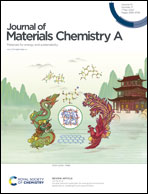Enhanced charge collection and surface activity of a CuBi2O4 photocathode via crystal facet engineering†
Abstract
Transition metal oxide semiconductors are important candidates for photoelectrodes to convert solar energy to fuels. However, the practical applications of these materials are hindered by severe carrier losses and sluggish electrochemical reactions. Hence, efficient collection of photogenerated charges and participation of these electrons in the surface reaction is critical. In this work, we sought to enhance the performance of photoelectrodes by modulating the crystal facets of transition metal oxides through theoretical designs and experimental validations. As a prototypical system, we demonstrated that CuBi2O4 (CBO) crystal can form a rod-like structure, where the surface region is dominated by the highly stable and active (002) facet. As a result, the designed CBO photocathode shows a threefold enhanced water reduction photocurrent and improved fill factor compared with ordinary grained CBO film. Using electrochemical impedance spectroscopy, transient photocurrent, and ultrafast spectroscopy analyses, we demonstrate that the improved performance is due to the enhanced electrochemical catalytic performance, higher efficiency of carrier collection, and charge utilization. Our work presents a new aspect of the rational design of high-efficiency photoelectrode systems in solar-fuel conversion.



 Please wait while we load your content...
Please wait while we load your content...